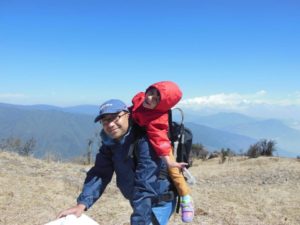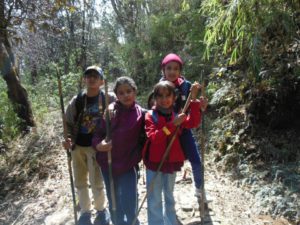While so many parents would like to trek with their children, the first question that keeps buzzing in the head noisily – Will he /she be able to walk?
Followed by – What if the weather turns bad?
And – What about the availability of food for my child?
Then there is the inevitable – What if my child falls sick?
Though not necessarily in this order, young parents, frequently plagued by these whats, often forego treks. Your three year old does not have to mean the end of your adventure on the trails. A bit of careful planning ahead, gathering information and a dash of intent may be all you will need to take off on to the dusty trail with your kids in tow. Let us discuss the enormous possibilities of trekking with children within the age group of 3 to 7 years.
You get to spend more time with your family in the outdoors.
Your children learns to become self sufficient from an early age.
They start learning from nature and get more observant.
They start learning to work with various challenges. Such experiences make them more adaptable to demanding situations.
As a mother, I observed these over the years. Maybe you can tell me more. My son was initiated into hiking from the age of five. And during all these years of hiking and trekking in the mountains, in the plateaus and along the coastal belts of my fabulous country, I have had the pleasure of meeting some incredible trekkers as young as three olds. I remember meeting this young gentleman Dipayan, all of seven years, at the Sandakphu trail, which is not less than 55 kms with the highest point at 11,930 feet. Never before have I seen a happier child marching along the rocky tracks with his parents following his footsteps. A couple of months later, Dipayan and his parents trekked an almost 70 km long trail with us, along the coastline of Bay of Bengal , in four days.
The best thing about children is that small things captivate their attention and keep them interested. They easily get attracted to colours, sounds and change of scenery. This is the best time to show and explain to them the uniqueness in cultures, lifestyles and people.

Problems brew in when they get tired, which they often do, after a good stretch of walking. That is also the time they lose interest in the surroundings. They start showing signs of boredom eventually breaking into wails and grouses. And a perfect day starts turning into a miserable one.
If you are a parent , who would like to take your child on a trek, let’s break down the apprehensions into few major ones and see how they can be overcome.
Anxiety : Will my child walk?
Answer : Probably yes.
How do I make that happen?
Start with small walks. Small walks around your locality help the child to get into the habit of walking and learning more about his/her surroundings. It is also a good idea to let the child know that the vacation will entail long walks for everyone. You do not really want to drop a surprise bomb on the child by keeping him/her in the dark about the walk and how long it is going to be. While packing for the trek, get your child involved. This gives them a sense of purpose and makes them feel important. My eight year old son was absolutely vexed in the last leg of trek from Gorkhey to Phalut and decided to sit down right in the middle of the trail and declared no go. As we looked at his face, flushed red, with anger and frustration, brother Taposh solved the matter within minutes. My son was made the team leader who had the responsibility of finding out whether rooms were available for the entire team at the GTA trekkers hut . The hut was still a good 2 kms from the point where he had plonked himself down on the trail. Vested with such a huge responsibility he immediately picked up his backpack and trotted off to the hut.
For beginners do not pick a trail that is difficult in terms of length or steepness. Start with short easy trails graduating slowly to longer or steeper ones.
If you still want to keep a back up plan, you can think of carrying a kid carrier meant for hiking . A good option is given in the link below.
Kid Comfort – Baby Carrier – Deuter
Baby Carrier Kid Comfort: Mountain adventures become much more pleasant with the ingenious, new Aircomfort Sensic Vario mesh…
In most of the Himalayan trails porter services are available. You can consider porter service for your child also. Porters are generally friendly with children

Anxiety: What if the weather turns bad?
Answer: “There is no such thing called bad weather, only different kinds of good weather”- John Ruskin.
You must be joking : No, really. The quality of your trek will depend on the clothing you carry. A sudden spell of shower may bring down the temperature dramatically, in the altitudes, even in summer. So bring the correct shoes and layers of clothing for yourself and your children. Do not miss out on any item. Thermals, full sleeve tee shirts, fleece jacket, padded jacket, woollen caps or balaclava, gloves, poncho or two piece rain suit, quick dry hiking pants, ankle length sports socks and woollen socks. You can carry a few extra pieces of clothing for your children.
Though monsoon treks are a feast for the senses, you have to take a lot of things into consideration if you have small children travelling with you. Monsoon in the Himalayan belts often mean road blocks and traffic snarls due to landslides. Mountain streams and rivers turn fierce, clothes will take forever to dry, visibility may be hindered by clouds and rain, contamination of drinking water sources cannot be ruled out and on top of everything there will be creepy crawlies, insects and leeches in many places , especially the Eastern Himalayas. What you can do from your part is
- Keep yourself updated with the weather conditions. Speak with the local people or your guide for better information.
- Keep extra days in hand in case you get stuck somewhere by heavy downpour, landslides or roadblocks.
- Do not forget to pack in your ponchos or two piece rainsuits. Quick dry hiking pants are the best choice for treks. They dry up way faster than the cotton pants.
- Carry insect /mosquito repellents.
Choosing standard trekking trails where access to emergency services are easier or where basic comforts can be provided by a third party, can really take away a lot of your worries. In many Himalayan trekking routes, trekkers huts or tea houses are available where you can stop for food and shelter. Apart from that, there are trek operators who would arrange a trek keeping the need and safety of your children in mind.
Anxiety : What if my child falls sick?
Answer: Prevention is always better than cure. Sicknesses which are frequent in trekking in altitudes are AMS, diarrhea, runny nose or fever due to exposure to cold climates
Workable solutions:
To ward off AMS
- Kids are just as likely to develop AMS as adults.
- The most effective way to escape AMS is descent.
- Start with treks about 3000 mts high.
- Maintain a slow rate of ascent to help the child to acclimatize to low oxygen levels and the decrease in air pressure, in areas above 8000 feet high.
- Consult your General Practitioner much before you start the trek.
Diarrhea
For small children carry cool, boiled water for drinking. Nearly all kitchens in tea houses or trekkers huts will provide you with boiled water at a nominal cost. Keep your child away from petting domestic animals on the route. Always clean their hands before meals. If sufficient water is not available during the walk using sanitary wipes to clean the hands will be of great help. Carry plenty of ORS sachets to ward off dehydration.
Carry small portable water filter with you. Something like
LifeStraw Personal Water Filter
OR Sawyer 1Gallon GravityWater Filtration system
OR Steripens
OR water purifying tablets from Shudhu or Hind Pharma
Exposure to cold climate:
Small children tend to lose heat faster than an adult. If the child is walking with you, she is generating some warmth for herself. But if a child is being carried by a porter clothe her with adequate layers so that she does not get cold. Porters usually are fast walkers. It would be advisable to ask the porter to walk along with you or wait for you after a certain time period because the layers of your child might need unwrapping or adding to regulate her temperature.
Carry nasal sprays for blocked noses. A child who can’t sleep at night because of a blocked nose will turn very irritable the next day.
If your base camp is in a town which is heavy in pollution getting a mask for your child will be a wise idea.
We hope that helps the parents. We are eager to hear from you too. So don’t forget to send in your suggestions.


I was very happy getting such son Dipayan (7 years old) who inspire me every time for new trekking after completing his first Trek Sandakphu.
Now we go for trek together (my wife, my son Dipayan and myself).
We enjoyed very much our first coastal trek with Somascamp.
The speciality trekking with Somascamp is that every time you can enjoy the beautiful nature during your walking without thinking much more. The arrangement was homely. Just one example.
Somascam arranged cadbury hot chocolate for my child. He was so happy getting such unexpected thing.
I didn’t have no prior information about cadbury hot chocolate. My child enjoyed very much with every member of trek family specialy Dev, Rana & Soma Di (Organizer).
As a parent, I want to convey my small experience that please motivate your child for trekking .
Can any adult come and join your camp ? If yes,how? Plz reply
Hi there! Such a great short article, thanks!